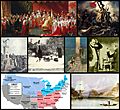1830s facts for kids
The 1830s were a busy time in history, full of big changes and new ideas! This decade saw the founding of new countries, important inventions, and the rise of famous leaders. It was a time when the world started to become more connected and new ways of thinking shaped the future.
Contents
Key Events of the 1830s
- A spiritual leader named Ayya Vaikundar appeared in Thiruchendur, India.
- The game of Croquet was invented in Ireland. It's a fun outdoor game played with mallets and balls.
- The Mormon religion was started in New York.
- The country of Belgium was founded. It became an independent nation after separating from the Netherlands.
- Ecuador declared its independence from Gran Colombia, becoming its own country.
- Queen Victoria became the ruler of Great Britain in 1837. Her long reign would see many changes and the growth of the British Empire.
Important People of the 1830s
Many important people were active during this decade, shaping the world around them. Here are a few:
Leaders and Rulers
- Queen Victoria (United Kingdom): She began her long and famous reign as Queen of the United Kingdom.
- Andrew Jackson (United States): He was the President of the United States during much of the 1830s.
- Martin Van Buren (United States): He became President after Andrew Jackson.
- Louis-Philippe (France): He was the King of France during the July Monarchy.
- Nicholas I (Russia): He was the Emperor of Russia.
- Ferdinand VII (Spain): He was the King of Spain.
Famous Births
Many people who would become famous were born in the 1830s:
- Emily Dickinson, a well-known American writer.
- Gustave Eiffel, a French engineer who designed the Eiffel Tower.
- Johannes Brahms, a famous German musician and composer.
- Alfred Nobel, a Swedish inventor who created dynamite and established the Nobel Prizes.
- Grover Cleveland, who would later become a President of the United States.
Notable Deaths
Some important figures passed away during this decade:
- Simón Bolívar, a military and political leader who helped many South American countries gain independence.
- Jean-François Champollion, a French scholar who was key to understanding ancient Egyptian hieroglyphs.
- Sir Walter Scott, a famous Scottish writer.
- James Weddell, a British explorer who traveled to the Antarctic.
- Alexander Puskin, a great Russian writer and poet.
Discoveries and Inventions
The 1830s were a time of exciting new discoveries and inventions that changed how people lived and worked.
Science and Exploration
- Electricity and Chemistry: Scientists like Michael Faraday and John Frederic Daniell made big steps in understanding electrochemistry. Their work helped us learn how to use electricity.
- The Voyage of the HMS Beagle: The ship HMS Beagle sailed around the world. On its second trip, Charles Darwin made important discoveries that helped him develop the theory of evolution. This theory changed how we understand biology and life on Earth.
New Technologies
- The Telegraph: Samuel Morse invented the telegraph. This amazing invention allowed people to send messages over long distances much faster than ever before. It was the first step towards global communication.
- Photography: The daguerreotype was introduced to the public in 1839. This was the first way for people to easily capture images. It was the beginning of modern photography.
Society and Culture
- Slavery in the United States: The number of states where slavery was allowed grew. This created big disagreements between different parts of the United States, which eventually led to the American Civil War.
- Fairy Tales: Hans Christian Andersen published his first collection of fairy tales in 1837. His stories, like The Little Mermaid, became very popular and are still loved today.
Images for kids
-
This collage shows many important events of the 1830s. Clockwise from top left: Queen Victoria's coronation began her long reign, during which the British Empire grew. France's 1830 revolution brought back liberal ideas. Michael Faraday and John Frederic Daniell studied electromagnetic induction, helping us understand electricity. The second voyage of HMS Beagle with Charles Darwin led to his theory of evolution. Slave and free states in the US grew, leading to big disagreements. The telegraph was invented by Samuel Morse, allowing fast communication. An 1832 daguerreotype shows early photography. Hans Christian Andersen published his first fairy tales, like The Little Mermaid.
-
L'Atelier de l'artiste. This is an 1837 daguerreotype by Louis Daguerre, who completed the full process.
-
Darwin's voyage aboard HMS Beagle.
See also
 In Spanish: Años 1830 para niños
In Spanish: Años 1830 para niños






